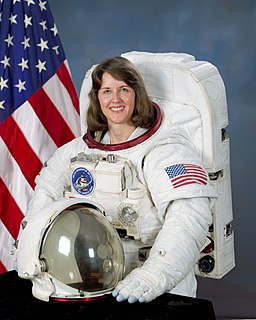
Jerome "Jay" Apt III, Ph.D. is an American astronaut and professor at Carnegie Mellon University. Before he became an astronaut, Apt was a physicist who worked on the Pioneer Venus 1978 space probe project, and used visible light and infrared techniques to study the planets and moons of the solar system from ground-based observatories.

Janice Elaine Voss was an American engineer and a NASA astronaut. Voss received her B.S. in engineering science from Purdue University, her M.S. in electrical engineering from MIT, and her PhD in aeronautics and astronautics from MIT. She flew in space five times, jointly holding the record for American women. Voss died in Arizona on February 6, 2012, from breast cancer.

William Benjamin "Bill" Lenoir was an American electrical engineer and NASA astronaut.

Byron Kurt Lichtenberg, Sc. D. is an American engineer and fighter pilot who flew aboard two NASA Space Shuttle missions as a Payload Specialist. In 1983, he and Ulf Merbold became the first Payload Specialists to fly on the shuttle.

Jeffrey Alan Hoffman is an American former NASA astronaut and currently a professor of aeronautics and astronautics at MIT.

Bonnie Jeanne Dunbar is an American engineer and retired NASA astronaut. She flew on five Space Shuttle missions between 1985 and 1998, including two dockings with the Mir space station. Since leaving NASA, she has worked in museums and STEM leadership, and as a professor of aerospace engineering.

Samuel Thornton Durrance (Ph.D.) is an American scientist who flew aboard two NASA Space Shuttle missions as a payload specialist.

Bernard Anthony Harris Jr. is a former NASA astronaut. On February 9, 1995, Harris became the first African American to perform an extra-vehicular activity (spacewalk), during the second of his two Space Shuttle flights.

Millie Elizabeth Hughes-Fulford was an American medical investigator, molecular biologist, and NASA payload specialist who flew aboard the NASA Space Shuttle Columbia in June 1991.

Fred Weldon Leslie is an American scientist who flew on the NASA STS-73 Space Shuttle mission as a payload specialist.

James Anthony "Jim" Pawelczyk is an American researcher of physiology and Kinesiology who flew aboard the NASA STS-90 Space Shuttle mission as a Payload Specialist.

Kathryn Ryan Cordell Thornton is an American scientist and a former NASA astronaut with over 975 hours in space, including 21 hours of extravehicular activity. She was the associate dean for graduate programs at the University of Virginia School of Engineering and Applied Science, currently a professor of mechanical and aerospace engineering.

Eugene Huu-Chau "Gene" Trinh is a Vietnamese American biochemist who flew aboard NASA Space Shuttle mission STS-50 as a Payload Specialist, becoming the first Vietnamese American astronaut in space and the second Vietnamese in space.

James Shelton Voss is a retired United States Army colonel and NASA astronaut. During his time with NASA, Voss flew in space five times on board the Space Shuttle and International Space Station. He also served as deputy of Flight Operations for the Space Station Program Mission Integration and Operations Office. While participating in ISS Expedition 2, he and Susan Helms conducted an 8-hour and 56 minute spacewalk, the longest to date.

Donald Alan Thomas, Ph.D. is an American engineer and a former NASA astronaut.

Stephanie Diana Wilson is an American engineer and a NASA astronaut. She flew to space onboard three Space Shuttle missions, and is the second African American woman to go into space, after Mae Jemison. As of 2021, her 42 days in space are the most of any female African American astronaut.

A payload specialist (PS) was an individual selected and trained by commercial or research organizations for flights of a specific payload on a NASA Space Shuttle mission. People assigned as payload specialists included individuals selected by the research community, a company or consortium flying a commercial payload aboard the spacecraft, and non-NASA astronauts designated by international partners.

Robert Lee "Bobby" Satcher Jr. is an American physician, chemical engineer, and former NASA astronaut. He participated in 2 spacewalks during STS-129, accumulating 12hrs 19min of EVA time. Satcher holds two doctorates and has received numerous awards and honors as a surgeon and engineer.

NASA Astronaut Group 9 was a group of 19 NASA astronauts announced on May 29, 1980, and completed their training by 1981. This group was selected to supplement the 35 astronauts that had been selected in 1978, and marked the first time that non-Americans were trained as mission specialists with the selections of ESA astronauts Claude Nicollier and Wubbo Ockels. In keeping with the previous group, astronaut candidates were divided into pilots and mission specialists, with eight pilots, eleven mission specialists, and two international mission specialists within the group.

NASA Astronaut Group 10 was a group of 17 astronauts that were announced on May 23, 1984 and consisted of seven pilots and ten mission specialists. Although selected in 1984, no member of the group would fly until 1988 due to the Challenger disaster and the resulting grounding of the Space Shuttle fleet.




















